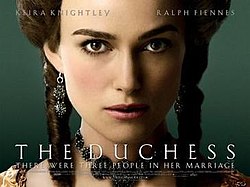Plot
In 1774, the young Georgiana is contracted in marriage to William Cavendish, Duke of Devonshire, with the expectation that she produce his male heir. She is quickly disillusioned by her husband, especially when Charlotte, an illegitimate child fathered by William whose mother has died, comes to live with them while Georgiana is pregnant. William expects Georgiana to tolerate the child's presence, and "practise mothering" on her.
When Georgiana gives birth to a girl, William is displeased. In his mind, he has fulfilled his obligations to her as her husband. However, by failing to provide him with a legitimate male heir, she has failed in her obligations as his wife.
Georgiana becomes a leading light in fashionable society. She socialises with the young Lady Bess Foster at Bath and invites her to live with them since Bess has nowhere else to go. William has an affair with her, causing Georgiana to feel robbed of her only friend and betrayed by Bess. Bess tells Georgiana that her motive is to regain her three sons (whom her husband has taken from her), so she continues to live with them.
Georgiana starts an affair with Charles Grey. They have known each other since their youth, and he declares he has always loved her. William is outraged when Georgiana suggests that since he has Bess, she should be allowed Charles. He rapes her; a male child is the product. Bess encourages the affair between Georgiana and Charles after the birth of Georgiana's son.
Soon, the whole of London society learns of Georgiana's affair. William threatens to end Charles's political career and forbids Georgiana from seeing her children again if she does not end the relationship. After initially refusing, Georgiana ends her relationship with Grey.
However, Georgina tells William that she is pregnant with Charles's child. She is sent to the countryside where she gives birth to her daughter with Grey, Eliza Courtney, who is given to the Grey family to raise as Charles's niece. Georgiana finds comfort in Bess's friendship when she gives birth to Eliza. Georgiana and William come to terms with one another, and along with Bess, continue their lives together.
The after-credits reveal Georgiana secretly visits her daughter Eliza. Eliza goes on to name her own daughter Georgiana, after her mother. Charles later becomes prime minister under William IV. Before she dies, Georgiana permits William and Bess to marry.
Production
The Duchess was produced by British Qwerty Films and American Magnolia Mae Films, with financial support from BBC Films, French Pathé, and Italian BIM Distribuzione. [3] The film was shot at Twickenham Film Studios and on location at Chatsworth, Bath, Holkham Hall, Clandon Park, Kedleston Hall, Somerset House, King's College London and the Old Royal Naval College in Greenwich.
Regarding lead actress Keira Knightley, director Saul Dibb said The Duchess was "a chance to take a character from late childhood – she's married at 17 – into full adulthood, 10 years later." [4] It was also a chance for Knightley to work with Ralph Fiennes, whom she regarded as one of her most accomplished co-stars to date; Dibb said, "When I said, 'We've got Ralph interested in playing the Duke,' we both took a gulp and went, 'F---.' [ sic ] ... But I didn't for one second feel that she wasn't up to the task." [4] Originally, the film was to be directed by Susanne Bier. [5]
Reception
Critical response
The film received mostly positive reviews. Rotten Tomatoes gives a score of 62% based on 170 reviews, with an average rating of 6.3/10. The site's consensus reads: "While The Duchess treads the now-familiar terrain of the corset-ripper, the costumes look great and Keira Knightley's performance is stellar in this subtly feminist, period drama." [12] Metacritic assigned the film a weighted average score of 62 out of 100, based on 34 critics, indicating "generally favorable reviews". [13]
Most reviewers highly praised Knightley and Fiennes' performances. Time Out London wrote: "[Saul Dibb] is also helped enormously by a mature, restrained portrayal from Knightley, a masterclass in passive aggression from Fiennes and a performance of tender seduction from Atwell." [14] Film Ireland writes "It is a slow movie, but it is well-acted with Knightley and Fiennes suited to their roles, especially Fiennes who gives a formidable and powerful performance." [15] Cameron Bailey, the co-chair of the Toronto International Film Festival comments, "The Duchess Of Devonshire, with Keira Knightley, which is a beautiful film and she gives a really mature performance. You're seeing her really turn into something beyond the kind of pretty face that we've seen her do already so well. But she's actually a very serious actress, and she's turning into a great, great performer." [16]
Peter Bradshaw of The Guardian wrote that "Dibb's movie looks good" but complained the film was "exasperatingly bland and slow-moving at all times" handing out a 2 of 5-star rating. However, Paul Hurley gave the film 8/10 and called The Duchess "an excellent new film" and states that "The Duchess stands a good chance of taking home some very big prizes at the end of the year". [17]
Roger Ebert gave the film 3.5 stars out of 4, writing, "I deeply enjoyed the film, but then I am an Anglophile. I imagine the behavior of the characters will seem exceedingly odd to some viewers. Well, it is." [18]
This page is based on this
Wikipedia article Text is available under the
CC BY-SA 4.0 license; additional terms may apply.
Images, videos and audio are available under their respective licenses.

